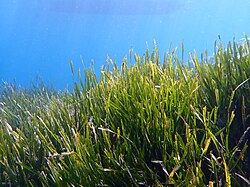| Posidonia Temporal range: | |
|---|---|
 | |
| Posidonia oceanica | |
| Scientific classification | |
| Kingdom: | Plantae |
| Clade: | Tracheophytes |
| Clade: | Angiosperms |
| Clade: | Monocots |
| Order: | Alismatales |
| Family: | Posidoniaceae Hutch. [2] |
| Genus: | Posidonia K.D.Koenig |
| Type species | |
| Posidonia oceanica | |
| Species | |
See text | |
 | |
| Posidonia distribution range | |
| Synonyms [3] | |
| |
Posidonia is a genus of flowering plants. It contains nine species of marine plants [4] ("seagrass"), found in the seas of the Mediterranean and around the south coast of Australia.
Contents
The APG system (1998) and APG II system (2003) accept this genus as constituting the sole genus in the family Posidoniaceae, which it places in the order Alismatales, in the clade monocots. The AP-Website [5] concludes that the three families Cymodoceaceae, Posidoniaceae and Ruppiaceae form a monophyletic group. Earlier systems classified this genus in the family Potamogetonaceae or in the family Posidoniaceae but belonging to order Zosterales.
Posidonia oceanica has nitrogen fixation capabilities via symbiosis and other species may as well. [6]